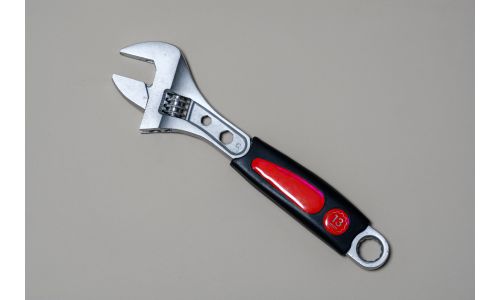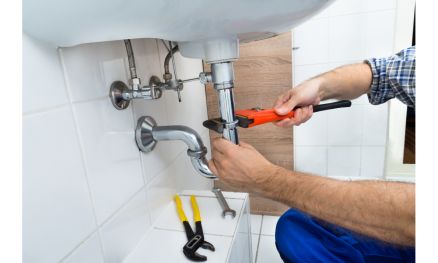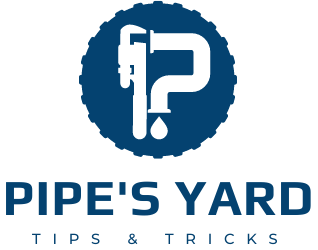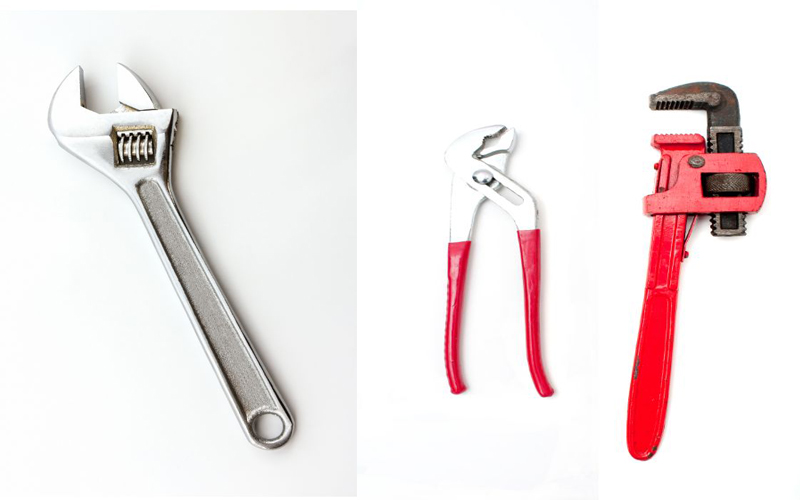Whether you’re working on pipes, bolts, or other hardware, monkey wrenches, and pipe wrenches serve as essential tools. At first glance, these wrenches may seem similar. However, they differ substantially.
How are they different? While the two have adjustable wrenches, they have different designs for specific uses. Monkey wrenches have lighter bodies and thin jaws for general work on small nuts and bolts. Pipe wrenches have heavier bodies and thick jaws to provide a higher grip for larger pipe fittings and bolts.
Monkey wrenches are more versatile, but pipe wrenches offer greater gripping power and are better for plumbing work. Understanding the contrasts between them will make it easy for you to select the right tool for the job.
A Comparison of Monkey Wrenches and Pipe Wrenches
The table below provides a comprehensive overview of the critical differences between monkey wrenches and pipe wrenches. It’s here to give you a head start on what will be discussed here.
| Aspects | Monkey Wrench | Pipe Wrench |
| Design | Two smooth or serrated jaws with a sliding lower jaw | Angled or serrated teeth on fixed and pivoting jaws |
| Range of Use | Grips nuts, bolts, and fasteners | Grips pipes and pipe fittings |
| Mechanical Advantage | Provides less mechanical advantage | Longer handle for higher torque |
| Precision of Grip | Less precise grip with potential for rounding off heads | Fairly snug grip with a secure grip on pipes |
| Potential for Damage | Less likely to damage smooth surfaces | May damage smooth or polished pipe surfaces |
| Size | Compact and portable, typically 6-24 inches | Larger sizes available, typically 10-48 inches |
| Ease of Use | Simple to use, adjust jaws and turn the handle | Requires adjusting jaws, tightening, and then turning |
What Is A Monkey Wrench?
A monkey wrench is a simple yet valuable tool invented by a Baltimore mechanic, Charles Moncky, in the 19th century. It has two main smooth jaws – a stationary upper jaw and a movable lower jaw. The lower jaw can slide up and down the wrench shaft, allowing it to grip objects of various sizes.
The name “monkey wrench” comes from how the lower jaw moves – it resembles a monkey climbing up and down a branch. The first monkey wrenches were large, flat iron pieces about 60 cm long.
A monkey wrench can be used to hold fasteners like bolts, nuts, and screws securely. You simply adjust the lower jaw to match the size of the fastener head, providing a snug grip.
What Are The Benefits Of Monkey Wrench?
A monkey wrench is quite popular and comes with its set of benefits. Here are the several advantages they provide:
- Work effectively on basic nuts and bolts: A monkey wrench can grip and turn nuts and bolts of different sizes thanks to the adjustable jaw. This makes it suitable for general DIY tasks that require tightening or loosening fasteners.
- Easy to find: Monkey wrenches are widely available at hardware stores, home improvement stores, and even some big box stores. You likely won’t have trouble finding one when you need it.
- Simple to use: Monkey wrenches require little instruction or training. Anyone can figure out how to adjust the jaw and turn the handle with some common sense.
- Work well in tight spaces: The relatively thin profile of monkey wrenches allows them to fit into tight areas where other tools won’t fit. This can be useful when working in confined spaces.
What Are The Disadvantages Of Monkey Wrench?
While monkey wrenches are useful for basic DIY tasks, they do have limitations. They include the following.
- Limited size range: Monkey wrenches can only grip nuts and bolts within a certain size range, depending on the size of the jaws. Larger or smaller fasteners will not fit.
- Lack of precision: The adjustable jaw of a monkey wrench does not provide a perfectly flush fit with fasteners, leading to slack and potential rounding off of nuts or bolt heads.
- No torque control: There is no mechanism to control the amount of torque or turning force applied. It is easy to overtighten nuts and bolts, potentially damaging or stripping them.
What Is A Pipe Wrench?
A pipe wrench is a type of wrench used to fit, secure and loosen components of pipe systems. It has adjustable jaws that can expand to grip different sizes of pipes.
Pipe wrenches are primarily used for installing, removing, and repairing pipes and pipe fittings. They are most commonly used to tighten or loosen circular fittings like elbows, tees, couplings, and unions that connect pipe sections.
Pipe wrenches are also used to install valves, connectors, and other attachments onto pipes. Their long handle provides a mechanical advantage, making it easier to apply high torque to tighten or loosen pipes and fittings.

What Are The Benefits Of Pipe Wrench?
Pipe wrenches offer exceptional versatility, and that comes with other advantages. Here are a few benefits of a pipe wrench:
- Gripping power: The angled teeth on the jaws of a pipe wrench provide a very strong grip on round pipes and fittings. This allows the wrench to generate high torque, making it ideal for tightening or loosening stuck or overtightened joints.
- Adjustability: The adjustable jaw of a pipe wrench allows it to grip pipes of different diameters. This means you only need one wrench for a wide range of pipes.
- Mechanical advantage: Their design, such as the long pipe wrench handle, acts as a lever, multiplying the applied force. This makes generating the high torque required to loosen or tighten stubborn pipe joints easier.
- Durability: High-quality pipe wrenches are made of hardened and tempered steel, making them resistant to wear and tear. They can last for many years with proper care and maintenance.
What Are The Disadvantages Of Pipe Wrench?
Pipe wrenches have their drawbacks too. Here are some of the disadvantages you need to be aware of:
- Damage to smooth surfaces: The serrated jaws of pipe wrenches can damage smooth or polished surfaces if used improperly. They are designed specifically for gripping pipes and threaded fittings.
- Weight: Longer pipe wrenches meant for bigger torque can be quite heavy, making them tiring to use for extended periods. However, some fiberglass and aluminum pipe wrenches aim to be lighter.
- Imprecise: Pipe wrenches do not have distinct teeth like box wrenches or sockets, so they are not as precisely fitted to fittings as other tools. This can lead to rounded or damaged fasteners.
- Higher risk of injuries: Remember, pipe wrenches are heavy. You have to ensure you use a pipe wrench properly, or else you might end up injuring yourself.
Monkey Wrench Vs. Pipe Wrench: What Are The Differences
As you can tell from the overviews above, it is easy to think they are made for the same use. However, they have their differences, which can tell you what or when to use them. These differences include:
I. Adjustable Jaws
One key difference lies in the design of the adjustable jaws. A monkey wrench has two smooth or serrated jaws. The lower jaw slides up and down the shaft to grip objects of different sizes.
In contrast, a pipe wrench has angled or serrated teeth on the fixed and pivoting jaws. The pivoting jaw rotates to expand and grip pipes of various diameters.
II. Range of Use
Because of their differently designed jaws, the tools have different ranges of use. A monkey wrench is suitable for gripping and turning nuts, bolts, and other fasteners with exposed heads. However, it cannot grip onto pipes.
On the other hand, a pipe wrench is exclusively designed to grip and rotate cylindrical objects like pipes and pipe fittings. It cannot work on nuts and bolts.
III. Mechanical Advantage
Another difference relates to mechanical advantage. A pipe wrench typically has a longer handle lever for generating higher torque. This makes it ideal for loosening or tightening stuck pipe fittings that require a lot of force.
In comparison, a monkey wrench has a shorter handle that provides a less mechanical advantage. It is sufficient for common DIY tasks but not as effective on stubborn fasteners.
IV. The Precision of Grip
The precision of grip also differs between the tools. A pipe wrench’s angled teeth and pivoting jaw provide a fairly snug and secure grip on pipes.
However, a monkey wrench’s sliding jaw does not offer as precise a fit with fasteners. This can potentially damage or rounded-off nut and bolt heads over time.
V. Potential for Damage
Due to their differently designed jaws, the tools also have varying potential to cause damage. The smooth or serrated jaws of a monkey wrench are less likely to damage smooth surfaces.
However, the angled and pointed teeth of a pipe wrench can potentially mar smooth or polished pipe surfaces if used carelessly.
VI. Size
Monkey wrenches typically range from 6 to 24 inches in length, thereby making them more compact and portable. By contrast, pipe wrenches come in larger sizes, from 10 to 48 inches, to accommodate larger diameter pipes. Consequently, their larger size enables them to generate higher torque.
VII. Ease of Use
Monkey wrenches is simpler to use since you just place the fixed jaws around the nut or bolt and turn. On the other hand, pipe wrenches require adjusting the curved jaws to the appropriate size to fit the pipe and tightening to increase the gripping force before turning. Hence, they are more complicated to operate.
Monkey Wrench Vs. Pipe Wrench: Which One Should You Choose?
Monkey wrenches and pipe wrenches differ significantly, making each tool suited for its respective purpose. Monkey wrenches are ideal for fastening and loosening nuts and bolt heads. This is thanks to their parallel fixed jaws that provide a secure grip.
Their simple design and ease of use make them a practical choice for basic tasks on flats and hexes.
In contrast, pipe wrenches are specially designed for gripping and turning round pipes and fittings. Their larger size, curved and adjustable jaws, and higher torque capabilities match the demands of working on pipes.
A monkey wrench will generally provide the best fit and control for tasks involving nuts, bolts, and other flat-faced hardware. While for installing, removing, and repairing pipes and pipe fittings, a pipe wrench will serve you better.
Its curved adjustable jaws will give you more grip and the torque needed for stubborn joints.
So, in short, match the tool to the task – use a monkey wrench for nuts and bolts and a pipe wrench for pipes.
Conclusion
Monkey wrenches, and pipe wrenches are both essential tools for different purposes. Monkey wrenches are ideal for fastening and loosening nuts and bolt headsets. At the same time, pipe wrenches are specially designed for gripping and turning round pipes and fittings.
Each tool has its own set of advantages and disadvantages, and it is important to choose the right tool for the job. Understanding the differences between these two wrenches can help you select the appropriate tool for your specific task. That ensures you get the job done efficiently and effectively.

